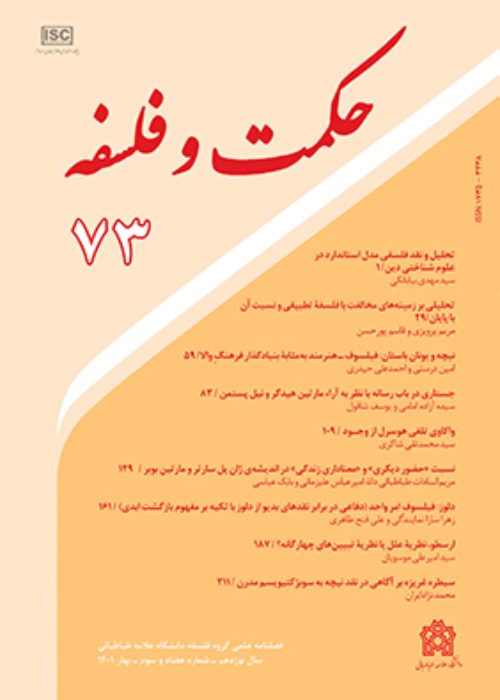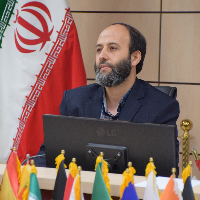Ontology of "Metaverse" and the Way of Perception in It Based on Mulla Sadra's Point of View
Metaverse technology due to its features such as being stable and permanent, not limited in time and space, and breaking some of the laws of the physical world has been given special attention by technology companies such as Meta and Microsoft, these companies are trying to launch a large and extensive social network to transform Metaverse technology into a world beyond the real world in the future, that users in Metaverse with the identity of an avatar and the use of smart tools such as mobile, laptop, etc. interact with one another. In fact, in this digital world, people no longer use the Internet, but live in it, and with the characters they have created, they experience a variety of social, cultural, political and economic interactions more actively, and more efficiently than in the real world.
Metaverse is still in its beginning, and the definitions and descriptions of this world are constantly changing, so it still has a long way to go to understand what the “Metaverse” world really is and what it will have on human society. However, it can be said that Metaverse with extraordinary features, can transform the technological horizons in human social and interactive life and create a new life experience for its users that will keep them away from traditional and natural life. Humans can create in this world and live in parallel with the physical and objective world in the world they have created. No doubt, these effects are cultural, social, legal, ... It will be for humans.
In this new life, humans can form new families and live in new territories with the identity and genders of the self-made avatar. This kind of life is some of the concepts that we are familiar with in the physical and objective world, such as borders, family, gender, ethnicity, etc.
This is the only important consequence of the metaverse that will make the thinkers and researchers act wisely in the face of this phenomenon. Therefore, it is essential that thinkers try to understand the different aspects of this phenomenon and clear the path to enter and traverse this world for the governing organizations and users so that this technology can be used to flourish human talents and minimize its potential damages. One of the cognitive dimensions that should be explained in this field is the ontology dimension of this phenomenon, neglecting this important issue due to the widespread impact of the Metaverse world on human life in the near future is considered a great neglect.
Due to the novelty of the Metaverse world theory in the literature of today's society, there has not been much scientific research in this field and the same few available researches have either been explained in terms of computer science, economics and architecture, or due to the unknown and obscurity of some of its dimensions for the human sciences thinkers with a pathological approach. Therefore, investigating the cognitive and ontological aspects of this phenomenon from the perspective of Islamic philosophy can be an innovative approach to this problem.
This essay with an ontological approach and descriptive and analytical method explains the nature of the Metaverse world and technologies that are effective in achieving users' perception of this world and then analyzes the way and type of human perception of Metaverse world based on Mulla Sadra's view.
The questions that will be answered in this essay are as follows:What is the nature of the Metaverse world and which technologies used in the Metaverse world play a role in human perception?
What is the ontological analysis of the Metaverse world and its features based on Mulla Sadra's view?
According to the types of perception in Mulla Sadra's view, what is the type and manner of human perception in the Metaverse world?
According to the foundations of Sadra'i philosophy, the perceptible space for the user in the Metaverse is not an Illusion and imagination space for three reasons, but it is a real and external perceptible space, because what is perceived in the Metaverse is the source of external effects, secondly, the perceptible beings in Metaverse have their own objective, partial, and special existence, thirdly, according to the interactive characteristics of this space, the personal perceptions of each user in Metaverse are conceivable for other users as well, so it cannot be an illusionary world.
According to the foundations of Mulla Sadra's ontology and the characteristics of Metaverse, Metaverse is a "hybrid external credit" world, and the entities that make up this space are both true and credit combinations. Also, the entities that make up Metaverse have a real, objective and tangible existence and have an external, partial, and special existence. The Metaverse is a type of tangible being, because this world consists of a series of tangible and perceptible components and has length, width, and depth, such as graphic images having three dimensions, sound waves, etc.
Therefore, because the Metaverse is a credit combination and has no identity other than the identity of its components, it is perceptible by the senses, and what can be understood by humans from the world of the Metaverse are subtle substances such as energy, waves, etc. that complications and attributes such as color, size, etc. are added to them so that they become perceptible to humans. In the Metaverse, users interact with each other in real time, so time in this world has meaning and is in line with real time. This world, like other creatures in the natural world, has movement and change.
By analyzing the characteristics of the Metaverse, it became clear that the place of existence of the Metaverse world is the world of nature; because the existence form of the beings that make up this world is matter (subtle body) and they have other perceptible characteristics of the natural world; like being tangible, having partial and objective existence, having width, length and depth, occupying space and movement, etc. In the epistemological analysis of the Metaverse world, it was determined that what is comprehensible to humans in the metaverse is made by two technologies, virtual reality, and augmented reality, which in virtual reality is sent to the user from only one input source of comprehensible information, and the tools used for perception are by the user among the preliminary and background causes the foundation for the realization of perception in the world of Metaverse. But in augmented reality, information can be understood by the user from two input sources at the same time; the real world, which is understood by the five senses, and the world that can be understood by humans through special tools that are the basis and introduction for perception. In a natural way and through technologies, it is perceived through human senses, and perception in this world is of the type of sensory perception; what is perceived are computer-generated sensations; such as three-dimensional graphic images, and... of course, it should be mentioned that unlike the underlying causes in the real space that are outside the domain of human will and discretion, the underlying causes (computer processes) in the virtual space and Metaverse are formed in the domain of human agency and will and with his awareness. The user can change his and others' sensory perceptions based on determining the type of information data.
What is perceived from the metaverse under two technologies, augmented reality and virtual reality, is based on the philosophical foundations of Mulla Sadra, of the partial acquisition type of perception. When this partial perception is done by the visual and auditory senses, they are of the type of sensory perceptions, and the perception of the other three senses is of the type of imaginary perception.
But another perception also occurs for users in the metaverse, and that is the perception of a user's personal imagination, which is transformed into an external reality by the computer and becomes perceptible to the individual and other users. These perceptions are the type of perception of forms and partial meanings, with the user's imagination; the imagination creates new images with the help of imagination, according to the will of the user, and these images are recognized by artificial intelligence and become sensations in the metaverse, where the visual and auditory perception of these "imaginary sensations" are of the sensory perception and their perception by the senses of smell, touch, and taste. And inner senses are of the type of imaginary perception.
Metaverse , Ontology , Perception , Mulla Sadra , Reality
- حق عضویت دریافتی صرف حمایت از نشریات عضو و نگهداری، تکمیل و توسعه مگیران میشود.
- پرداخت حق اشتراک و دانلود مقالات اجازه بازنشر آن در سایر رسانههای چاپی و دیجیتال را به کاربر نمیدهد.



